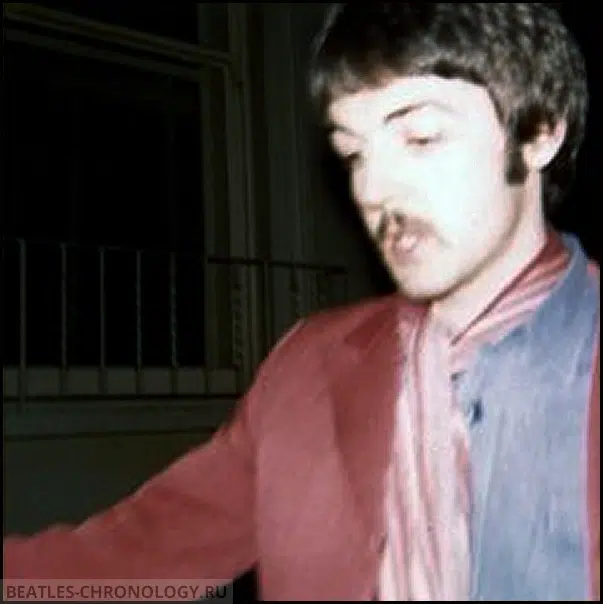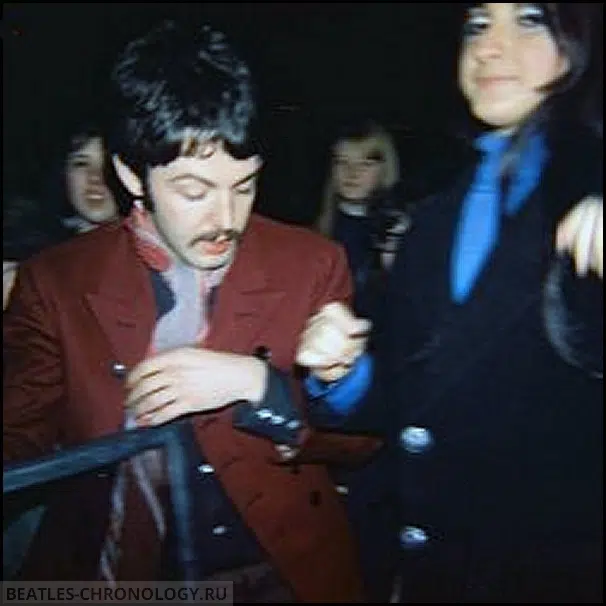Monday, March 13, 1967
Recording "Good Morning Good Morning"
For The Beatles
Last updated on February 10, 2024
Monday, March 13, 1967
For The Beatles
Last updated on February 10, 2024
Recording "Sgt. Pepper's Lonely Hearts Club Band"
Nov 24, 1966 - Apr 20, 1967 • Songs recorded during this session appear on Sgt. Pepper's Lonely Hearts Club Band (UK Mono)
Recording studio: EMI Studios, Studio Two, Abbey Road
Session Mar 09, 1967 • Recording "Getting Better"
Session Mar 10, 1967 • Recording "Getting Better"
Session Mar 13, 1967 • Recording "Good Morning Good Morning"
Article Mar 15, 1967 • Peter Blake and Jann Haworth have dinner at Paul’s
Some of the songs worked on during this session were first released on the "Sgt. Pepper's Lonely Hearts Club Band (UK Mono)" LP.
On February 8, 1967, The Beatles recorded the rhythm track of John Lennon’s song “Good Morning Good Morning” and added overdubs on February 16. The track was then put on hold for almost a month before being worked on again during this session, which began at 7 pm and ended at 2:30 am.
The purpose of this session was to record a brass overdub for which three members of Sounds Incorporated, a group managed by Brian Epstein, were recruited to play saxophones. These musicians were Barrie Cameron, David Glyde, and Alan Holmes. Sounds Incorporated had previously opened for The Beatles during their 1965 world tour. John Lee on trombone and an unknown trombone player, along with a French horn player simply known as Tom, were also recruited for this session.
However, the session started with a 2-3 hour chat that turned into a listening session of the current stage of the “Sgt. Pepper” tracks for the benefit of the Sounds Incorporated players.
The brass overdub was then recorded and added to track two of the four-track tape of Take 10 and was subjected to heavy limiting and compression to alter the sound.
Work on “Good Morning Good Morning” continued on March 28, 1967.
When we came to record it we used Sounds Incorporated to do a big sax thing; they were friends of ours who had been on tour with us.
Paul McCartney – From “Paul McCartney: Many Years from Now” by Barry Miles, 1997
We were there for about six hours. The first three hours we had refreshments and The Beatles played us the completed songs for the new LP.
Alan Holmes – From “The Complete Beatles Recording Sessions” by Mark Lewisohn, 1988
The Beatles had been cloistered in the studio for so long, they were clearly suffering from cabin fever. In addition, few people outside of our small inner circle had heard any of the Pepper tracks, so as everyone sat downstairs catching up with one another and reminiscing about old times, we were asked to play mixes of the completed tracks through the studio speakers. […]
I was studying the expressions of the Sounds Incorporated guys, trying to measure their reactions to the tracks we were playing for them. They were mesmerized! We knew that what we had been doing was exceptional, but it was gratifying to see that kind of response from people fresh to the project. From that point on, every time anyone came to visit the Beatles on a session, Richard and I hoped that we would be asked to play back something that was completed, or in progress, not just because we loved hearing the tracks, but because we enjoyed seeing the stunned looks on their faces.
Geoff Emerick – From “Here, There and Everywhere: My Life Recording the Music of The Beatles“, 2006
The basic tune was quite simple, but John wanted a very hard driving sound to punch it along. This is where the horns came in. I thought the way to do it would be to have a mixture of saxophones, trumpets and trombones playing either in unison or in octaves, and sometimes on spread chords. It so happened that Brian Epstein managed a group called Sounds Incorporated, who were good pals, if a bit crazy, so we brought them in to give us our horn sound. They worked with us all day on it — and they had a very hard time.
John’s rhythms, so natural to his ear, were the very devil for thesix players to deliver in perfect time. They had to count like mad to know exactly when to do the ‘stabs’. It was very easy for them to miss cues, and very hard indeed to hit them as one, bang on.
George Martin – From “With A Little Help From My Friends: The Making of Sgt. Pepper“, 1995
For nearly a month, John had been ruminating about what kind of instrumentation he wanted on “Good Morning Good Morning”. He finally decided to add brass, but he was adamant that it mustn’t sound “ordinary,” and he insisted that George Martin hire a horn section comprised of old Liverpool mates instead of the top-flight session musicians we had been using. The group, who called themselves Sounds Incorporated, were nice enough blokes – actually, they were a lot of fun, which explained why Lennon liked them so much. But it took quite a long time to get a good take out of them because, throughout the session, John kept complaining that they were playing too “straight” — he had a real bee in his bonnet about that. In the end, to satisfy Lennon’s demand that I take a different sonic approach, I shoved the mics right down the bells of the saxes and screwed the sound up with limiters and a healthy dose of effects like flanging and ADT; we pretty much used every piece of equipment at hand.
Geoff Emerick – From “Here, There and Everywhere: My Life Recording the Music of The Beatles“, 2006
They spent a long time doing the overdub, about three hours or maybe longer, but John Lennon thought it sounded too straight. So we ended up flanging, limiting and compressing it, anything to make it sound unlike brass playing. It was typical John Lennon – he just wanted it to sound weird.
Richard Lush, tape operator – From “The Complete Beatles Recording Sessions” by Mark Lewisohn, 1988



Recording • SI onto take 10
The Complete Beatles Recording Sessions • Mark Lewisohn
The definitive guide for every Beatles recording sessions from 1962 to 1970.
We owe a lot to Mark Lewisohn for the creation of those session pages, but you really have to buy this book to get all the details - the number of takes for each song, who contributed what, a description of the context and how each session went, various photographies... And an introductory interview with Paul McCartney!
The Beatles Recording Reference Manual: Volume 3: Sgt. Pepper's Lonely Hearts Club Band through Magical Mystery Tour (late 1966-1967)
The third book of this critically - acclaimed series, nominated for the 2019 Association for Recorded Sound Collections (ARSC) award for Excellence In Historical Recorded Sound, "The Beatles Recording Reference Manual: Volume 3: Sgt. Pepper's Lonely Hearts Club Band through Magical Mystery Tour (late 1966-1967)" captures the band's most innovative era in its entirety. From the first take to the final remix, discover the making of the greatest recordings of all time. Through extensive, fully-documented research, these books fill an important gap left by all other Beatles books published to date and provide a unique view into the recordings of the world's most successful pop music act.
If we modestly consider the Paul McCartney Project to be the premier online resource for all things Paul McCartney, it is undeniable that The Beatles Bible stands as the definitive online site dedicated to the Beatles. While there is some overlap in content between the two sites, they differ significantly in their approach.

Notice any inaccuracies on this page? Have additional insights or ideas for new content? Or just want to share your thoughts? We value your feedback! Please use the form below to get in touch with us.